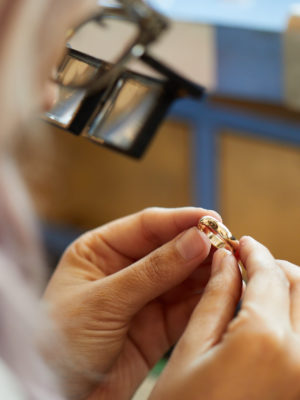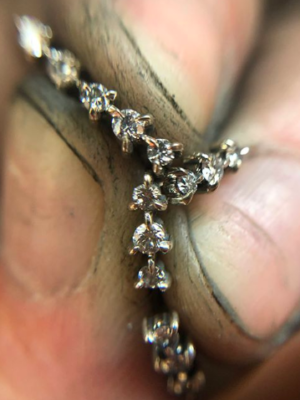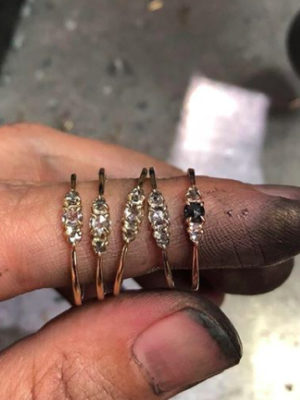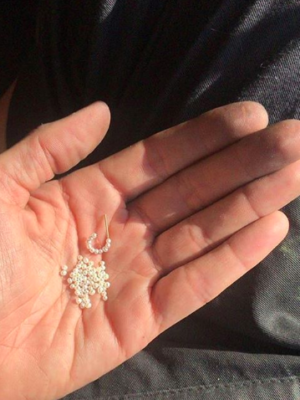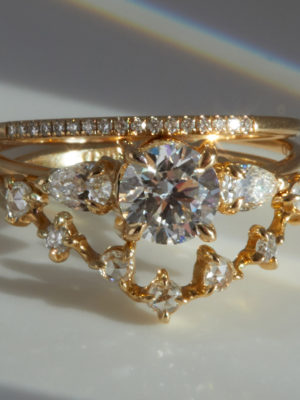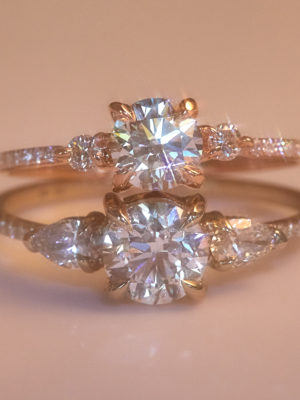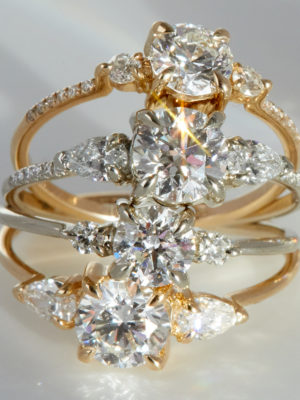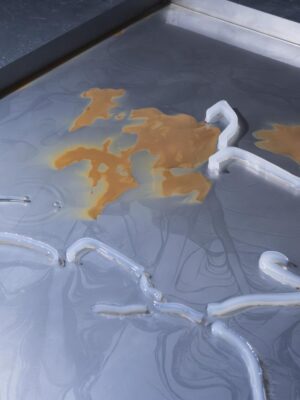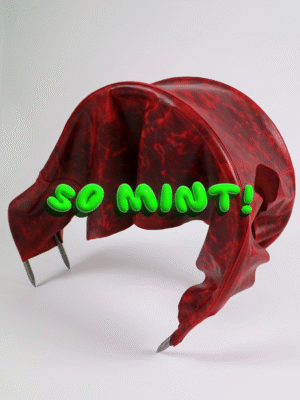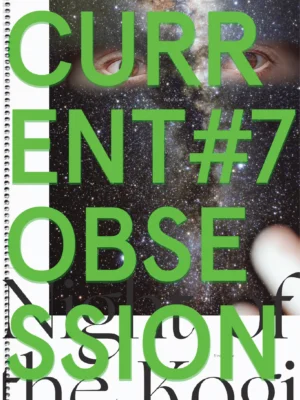Catbird jewelry has also come to represent a young generation of women who buy jewelry for themselves, inspired by how social media has changed our relationship to self-representation. These women customize and improvise, mixing vintage with contemporary, cheap with luxurious, designer with flea. Images of highly personalized styles are posted online, where the daring combos are appreciated and the haters advised to unfollow.As these two tribes sail into the wide streams of Instagram, they overlap, mingle, and create a beautiful and empowering image of a sisterhood connecting the makers with the wearers of these pieces. It feels natural, then, that Catbird came up with the concept “Forever Sweet Nothing”—an event-only project with a performative aspect. A Catbird jeweler “zaps” or micro-solders gold wrists or ankle bracelets directly onto the customer, creating an intimate moment of interaction between the two and the perfect forever jewel.That’s what makes the Catbird culture and narrative so appealing. The delicate designs released into the world by the two women behind Catbird—Rony Vardi and Leigh Batnick Plessner—speak to the very essence of today’s modern women, their freedom in decision-making and their lifestyle choices.Current Obsession catches up with Rony and Leigh to find out more…
Marina Elenskaya: Describe what Catbird culture is to you, maybe focusing on how the culture around the brand has solidified over the years.
Leigh Batnick Plessner: To me, Catbird culture has grown out of our tiny shop on Bedford. It is kindness to ourselves, our customers, our community, and the delight of getting to swim in tiny jewelry and tiny details while always remembering that the world can be scant in such pleasures.
Rony Vardi: Leigh put it perfectly. Piggybacking on that, something baked into our ethos is that we do not work on commission or sales goals. Our motivation is only to make people feel good—in the store, online, on the phone—and to help them find something that makes them, or someone they love, happy.
___STEADY_PAYWALL___
I love this quote from you, Rony: “We’re growing up alongside them [the customers] and designing pieces for the next phase in their life. It’s a little more sophisticated, something we feel a woman could buy herself to celebrate a promotion or to mark an anniversary.”
With an entry point as low as $44 for your iconic Threadbare ring, Catbird jewelry appeals to the young audience; the collector inside each of us awakens at the possibility of stacking, customizing, personalizing. Catbird, therefore, keeps a loyal customer base always coming back for more.
This is a brilliant strategy. Can you talk more about it and its inception? And if it happened naturally, maybe you could talk about when you first realized this was a thing?
LBP: It was a happy accident! When you work around jewelry, it’s easy to accumulate a lot (though I am pretty regimented in my own acquisitions, I was less so when I worked in a patisserie in high school!) And I love jumbly things, so rings started piling higher on my fingers. I do remember when Rony one day stated her intent to begin a fancy ring stack and around that same time a customer came in wearing a pile of antique rings on her finger. Lots of our designers wore their rings that way, too, and there are all sorts of museum-y portraits where subjects are wearing ring stacks. It’s narrative, sedimentary, souvenirs of life. Every ring that I wear means something to me, like a little private spider’s web twisted around my fingers.
RV: It’s true—stacking was never a strategy but a natural way to style that fits our aesthetic and I think is classic and beautiful. I love an unstudied jumble.
“Our store makes us a real boy, like Pinocchio.”
—Leigh Batnick Plessner
With over 60% of your sales taking place online, you still love having a bricks-and-mortar store. Why is it important for you to meet your customers face-to-face?
LBP: Our store makes us a real boy, like Pinocchio. Because we are in a city that so many people come to visit, the chance of getting to meet the people who follow us from all over the world is likelier than almost anywhere else, I think. New York is such a part of Catbird, and to get to be a slice of a moment in someone’s first trip to New York—something they imagine, like going to the Met because they loved it in From the Mixed-up Files of Mrs Basil E Frankweiler—is an idea that will never get old. Zapping is a way to offer a special souvenir that we can only do in our neighborhood, in our little place. It’s a perk of coming to visit!
RV: Many years ago, in 2008 or 2009, we sold a branch-y, delicate gold ring with white sapphires for $218, which was at the high end of our offerings. At some point we saw that some of our existing customers were buying it as their engagement ring. We had neither the resources nor the confidence to start investing in high-end rings at the time, but it was [when we started] paying attention and reacting to our changing neighborhood. Also, many people stay at Catbird for a long time so we ourselves have grown with Catbird!
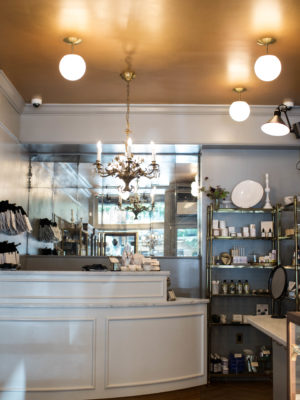
Customer feedback seems to play a big role in the decisions you make.
I feel that sometimes the problem with upcoming jewelry designers is that they do the opposite: they put their “brainchildren” out in the world, and expect the audience to follow. And often fail. Do you see those two approaches as opposing one another, or do you think it’s worth taking risks and putting your craziest ideas out there?
LBP: I think these two concepts can work side-by-side brilliantly! We make, and do, mainly what we love and what feels right for Catbird. What feels like us responding to customer feedback is us knowing Catbird, like the backs of our (well-jeweled) hands. If you know yourself, your audience/customer will see that and feel safe. It is most exciting to give people what they never knew they wanted, the thing that they couldn’t ask for because they didn’t know they desired it.
Leigh, you mention language when asked about inspiration: how phrases from old jewelry books, or the way the old masters refer to the smallest details, spark your imagination. I think it’s so interesting, given that most students today collect pins on Pinterest or make archives on Instagram. Could you talk more about your process of language leading to form? Maybe give an example?
LBP: I collect meaningful jewelry mentions from the (mostly old) novels I read. A prized possession is this line from Those Who Leave and Those Who Stay by Elena Ferrante: “In her ears, around her neck, against the dark dress that hung loosely, gold sparkled as if she were getting ready for a party.” We named our Greco Lariat [necklace] for Elena Greco from Ferrante’s Neapolitan Novels.
RV: Leigh and I talk a lot about language and we work together on naming our pieces. We share a love—and lists—of words that resonate with us that we can draw upon.
“In her ears, around her neck, against the dress that hung loosely, gold sparkled as if she were getting ready for a party.”
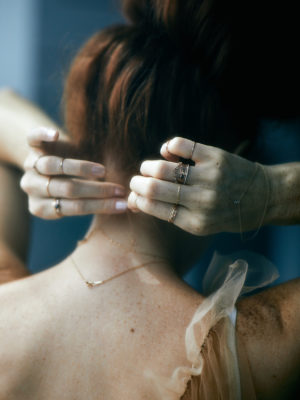
Besides producing its own jewelry and being a launchpad for upcoming fine fashion jewelry designers, Catbird also supports its own bench-jewelers to develop their own work. I believe several of your bench-jewelers were able to launch their work through Catbird, is that correct?
I also heard that jewelers are allowed to spend some time after hours at the Catbird studio and work on their own pieces; they are also encouraged to take professional courses. These, by far, are the most awesome things a company could do for their workers. Could you talk a little bit about that? How did this come about? It seems like you are not afraid of competition, instead you chose to support your jewelers.
LBP: We carry the lines of four women who are, or were at one point, jewelers of ours—Claire Kinder, Leo Black, Jack + G, and Bruce. We were the first retailers to stock Leo and Bruce. Launching lines is so exciting and doubly so when they come from our jewelers. Jewelers submit their work in the same way as any other designer would—I religiously answer 99.9% of all designer submission emails. I’m always happy to sit with them and help refine prices, line sheets, assortment. I do try to tread lightly (but honestly!) with feedback because I can only speak for Catbird and our idiosyncrasies; what might not be right for us could be just the thing for another retailer.
Street style photography and social media has had an impact on how young women choose to adorn themselves. This obviously goes for the celebrity cult and how the younger generation is being primed to consume luxury goods, too. But what Catbird is doing is creating a cult of its own with #catbirdjewelers. Looking up the profiles of the tagged bench-jewelers, one discovers beautiful, independent women living glamorous New York lives. This hashtag was the first thing that fascinated me about Catbird.
Is this a conscious marketing strategy or something that happened and took off? Now that it is a thing, do you see it/your jewelers as marketing tools?
LBP: Was not conscious! I think that the jewelers started using that hashtag, and I adopted it from them. Rabbit holes and good-hearted snooping are the great pleasures of the internet, and our jewelers are a very glorious bunch!
RV: The community and culture at Catbird is, above all else, what I am most proud of. Working among people who take pride in their work (and this is not just the jewelers, but literally everyone here) is a joy on a daily basis. The #catbirdjewelers hashtag is a great part of that.
Visit the flagship store
219 Bedford Ave
Brooklyn
This article was first published in the #6 Current Obsession Paper for New York City Jewelry Week
